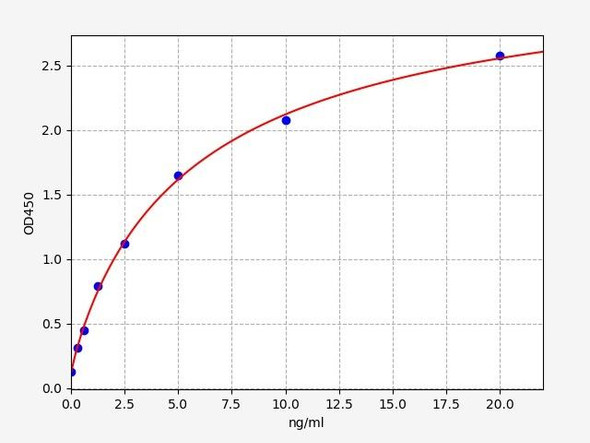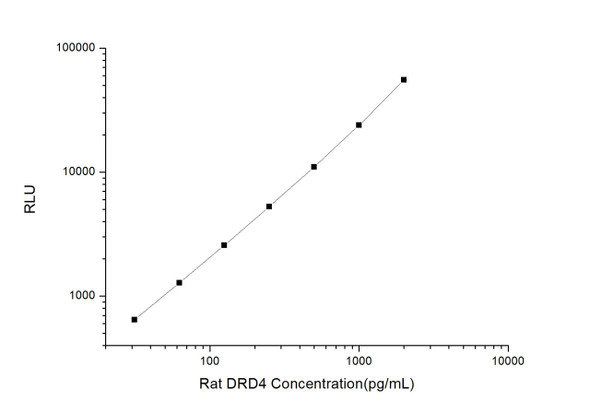Rat Signaling ELISA Kits 2
Rat DRD3 (Dopamine Receptor D3) CLIA Kit (RTES00185)
- SKU:
- RTES00185
- Product Type:
- ELISA Kit
- ELISA Type:
- CLIA Kit
- Size:
- 96 Assays
- Sensitivity:
- 37.5pg/mL
- Range:
- 62.5-4000pg/mL
- ELISA Type:
- Sandwich
- Reactivity:
- Rat
- Sample Type:
- Serum, plasma and other biological fluids
Description
| Assay type: | Sandwich |
| Format: | 96T |
| Assay time: | 4.5h |
| Reactivity: | Rat |
| Detection method: | Chemiluminescence |
| Detection range: | 62.50-4000 pg/mL |
| Sensitivity: | 37.50 pg/mL |
| Sample volume: | 100µL |
| Sample type: | Serum, plasma and other biological fluids |
| Repeatability: | CV < 15% |
| Specificity: | This kit recognizes Rat DRD3 in samples. No significant cross-reactivity or interference between Rat DRD3 and analogues was observed. |
This kit uses Sandwich-CLIA as the method. The micro CLIA plate provided in this kit has been pre-coated with an antibody specific to Rat DRD3. Standards or samples are added to the appropriate micro CLIA plate wells and combined with the specific antibody. Then a biotinylated detection antibody specific for Rat DRD3 and Avidin-Horseradish Peroxidase (HRP) conjugate are added to each micro plate well successively and incubated. Free components are washed away. The substrate solution is added to each well. Only those wells that contain Rat DRD3, biotinylated detection antibody and Avidin-HRP conjugate will appear fluorescence. The Relative light unit (RLU) value is measured spectrophotometrically by the Chemiluminescence immunoassay analyzer. The RLU value is positively associated with the concentration of Rat DRD3. The concentration of Rat DRD3 in the samples can be calculated by comparing the RLU of the samples to the standard curve.
| UniProt Protein Function: | DRD3: Dopamine receptor whose activity is mediated by G proteins which inhibit adenylyl cyclase. Promotes cell proliferation. Genetic variation in DRD3 is associated with essential tremor hereditary type 1 (ETM1). ETM1 is the most common movement disorder. The main feature is postural tremor of the arms. Head, legs, trunk, voice, jaw, and facial muscles also may be involved. The condition can be aggravated by emotions, hunger, fatigue and temperature extremes, and may cause a functional disability or even incapacitation. Inheritance is autosomal dominant. Belongs to the G-protein coupled receptor 1 family. 2 isoforms of the human protein are produced by alternative splicing. |
| UniProt Protein Details: | Protein type:Membrane protein, multi-pass; Receptor, GPCR; GPCR, family 1; Membrane protein, integral Cellular Component: apical part of cell; cell projection; endocytic vesicle; integral to plasma membrane; membrane; plasma membrane Molecular Function:D1 dopamine receptor binding; dopamine binding; dopamine D1 receptor-like receptor activity; dopamine D2 receptor-like receptor activity; dopamine receptor activity; drug binding; protein binding; protein domain specific binding Biological Process: acid secretion; arachidonic acid secretion; behavioral response to cocaine; cellular calcium ion homeostasis; circadian regulation of gene expression; dopamine receptor signaling pathway; dopamine receptor, adenylate cyclase activating pathway; dopamine receptor, adenylate cyclase inhibiting pathway; G-protein coupled receptor internalization; G-protein coupled receptor protein signaling pathway; locomotory behavior; musculoskeletal movement, spinal reflex action; negative regulation of adenylate cyclase activity; negative regulation of blood pressure; negative regulation of dopamine receptor signaling pathway; negative regulation of oligodendrocyte differentiation; negative regulation of protein kinase B signaling cascade; negative regulation of protein secretion; negative regulation of sodium:hydrogen antiporter activity; negative regulation of transcription from RNA polymerase II promoter; positive regulation of cell proliferation; positive regulation of cytokinesis; positive regulation of dopamine receptor signaling pathway; positive regulation of mitosis; positive regulation of transcription from RNA polymerase II promoter; prepulse inhibition; regulation of cAMP metabolic process; regulation of circadian sleep/wake cycle, sleep; regulation of dopamine secretion; regulation of lipid metabolic process; regulation of locomotion; regulation of multicellular organism growth; renin-angiotensin regulation of blood volume; response to amphetamine; response to cocaine; response to drug; response to ethanol; response to morphine; synaptic transmission, dopaminergic; visual learning |
| NCBI Summary: | may be involved in facilitating the effects of antipsychotic drugs and drug treatments for Parkinson's disease [RGD, Feb 2006] |
| UniProt Code: | P19020 |
| NCBI GenInfo Identifier: | 118211 |
| NCBI Gene ID: | 29238 |
| NCBI Accession: | P19020. 1 |
| UniProt Secondary Accession: | P19020,P70647, |
| UniProt Related Accession: | P19020 |
| Molecular Weight: | Predicted: 50 kDa |
| NCBI Full Name: | D(3) dopamine receptor |
| NCBI Synonym Full Names: | dopamine receptor D3 |
| NCBI Official Symbol: | Drd3 |
| NCBI Protein Information: | D(3) dopamine receptor |
| UniProt Protein Name: | D(3) dopamine receptor |
| UniProt Synonym Protein Names: | Dopamine D3 receptor |
| Protein Family: | D(3) dopamine receptor |
| UniProt Gene Name: | Drd3 |
| UniProt Entry Name: | DRD3_RAT |
As the RLU values of the standard curve may vary according to the conditions of the actual assay performance (e. g. operator, pipetting technique, washing technique or temperature effects), the operator should establish a standard curve for each test. Typical standard curve and data is provided below for reference only.
| Concentration (pg/mL) | RLU | Average | Corrected |
| 4000 | 55173 62989 | 59081 | 59046 |
| 2000 | 26372 29346 | 27859 | 27824 |
| 1000 | 14463 12505 | 13484 | 13449 |
| 500 | 6146 7064 | 6605 | 6570 |
| 250 | 3449 3037 | 3243 | 3208 |
| 125 | 1599 1563 | 1581 | 1546 |
| 62.50 | 709 801 | 755 | 720 |
| 0 | 34 36 | 35 | -- |
Precision
Intra-assay Precision (Precision within an assay): 3 samples with low, mid range and high level Rat DRD3 were tested 20 times on one plate, respectively.
Inter-assay Precision (Precision between assays): 3 samples with low, mid range and high level Rat DRD3 were tested on 3 different plates, 20 replicates in each plate.
| Intra-assay Precision | Inter-assay Precision | |||||
| Sample | 1 | 2 | 3 | 1 | 2 | 3 |
| n | 20 | 20 | 20 | 20 | 20 | 20 |
| Mean (pg/mL) | 219.85 | 510.66 | 1716.98 | 216.22 | 557.03 | 1623.01 |
| Standard deviation | 23.28 | 56.27 | 174.79 | 24.71 | 58.88 | 148.99 |
| C V (%) | 10.59 | 11.02 | 10.18 | 11.43 | 10.57 | 9.18 |
Recovery
The recovery of Rat DRD3 spiked at three different levels in samples throughout the range of the assay was evaluated in various matrices.
| Sample Type | Range (%) | Average Recovery (%) |
| Serum (n=5) | 97-112 | 103 |
| EDTA plasma (n=5) | 88-101 | 95 |
| Cell culture media (n=5) | 99-115 | 107 |
Linearity
Samples were spiked with high concentrations of Rat DRD3 and diluted with Reference Standard & Sample Diluent to produce samples with values within the range of the assay.
| Serum (n=5) | EDTA plasma (n=5) | Cell culture media (n=5) | ||
| 1:2 | Range (%) | 99-113 | 86-100 | 99-115 |
| Average (%) | 107 | 92 | 105 | |
| 1:4 | Range (%) | 89-102 | 96-110 | 88-104 |
| Average (%) | 96 | 102 | 96 | |
| 1:8 | Range (%) | 90-102 | 90-105 | 88-100 |
| Average (%) | 95 | 96 | 93 | |
| 1:16 | Range (%) | 87-100 | 93-104 | 95-110 |
| Average (%) | 93 | 99 | 100 |
An unopened kit can be stored at 4°C for 1 month. If the kit is not used within 1 month, store the items separately according to the following conditions once the kit is received.
| Item | Specifications | Storage |
| Micro CLIA Plate(Dismountable) | 8 wells ×12 strips | -20°C, 6 months |
| Reference Standard | 2 vials | |
| Concentrated Biotinylated Detection Ab (100×) | 1 vial, 120 µL | |
| Concentrated HRP Conjugate (100×) | 1 vial, 120 µL | -20°C(shading light), 6 months |
| Reference Standard & Sample Diluent | 1 vial, 20 mL | 4°C, 6 months |
| Biotinylated Detection Ab Diluent | 1 vial, 14 mL | |
| HRP Conjugate Diluent | 1 vial, 14 mL | |
| Concentrated Wash Buffer (25×) | 1 vial, 30 mL | |
| Substrate Reagent A | 1 vial, 5 mL | 4°C (shading light) |
| Substrate Reagent B | 1 vial, 5 mL | 4°C (shading light) |
| Plate Sealer | 5 pieces | |
| Product Description | 1 copy | |
| Certificate of Analysis | 1 copy |
- Set standard, test sample and control (zero) wells on the pre-coated plate and record theirpositions. It is recommended to measure each standard and sample in duplicate. Note: addall solutions to the bottom of the plate wells while avoiding contact with the well walls. Ensuresolutions do not foam when adding to the wells.
- Aliquot 100µl of standard solutions into the standard wells.
- Add 100µl of Sample / Standard dilution buffer into the control (zero) well.
- Add 100µl of properly diluted sample (serum, plasma, tissue homogenates and otherbiological fluids. ) into test sample wells.
- Cover the plate with the sealer provided in the kit and incubate for 90 min at 37°C.
- Aspirate the liquid from each well, do not wash. Immediately add 100µL of BiotinylatedDetection Ab working solution to each well. Cover the plate with a plate seal and gently mix. Incubate for 1 hour at 37°C.
- Aspirate or decant the solution from the plate and add 350µL of wash buffer to each welland incubate for 1-2 minutes at room temperature. Aspirate the solution from each well andclap the plate on absorbent filter paper to dry. Repeat this process 3 times. Note: a microplatewasher can be used in this step and other wash steps.
- Add 100µL of HRP Conjugate working solution to each well. Cover with a plate seal andincubate for 30 min at 37°C.
- Aspirate or decant the solution from each well. Repeat the wash process for five times asconducted in step 7.
- Add 100µL of Substrate mixture solution to each well. Cover with a new plate seal andincubate for no more than 5 min at 37°C. Protect the plate from light.
- Determine the RLU value of each well immediately.






